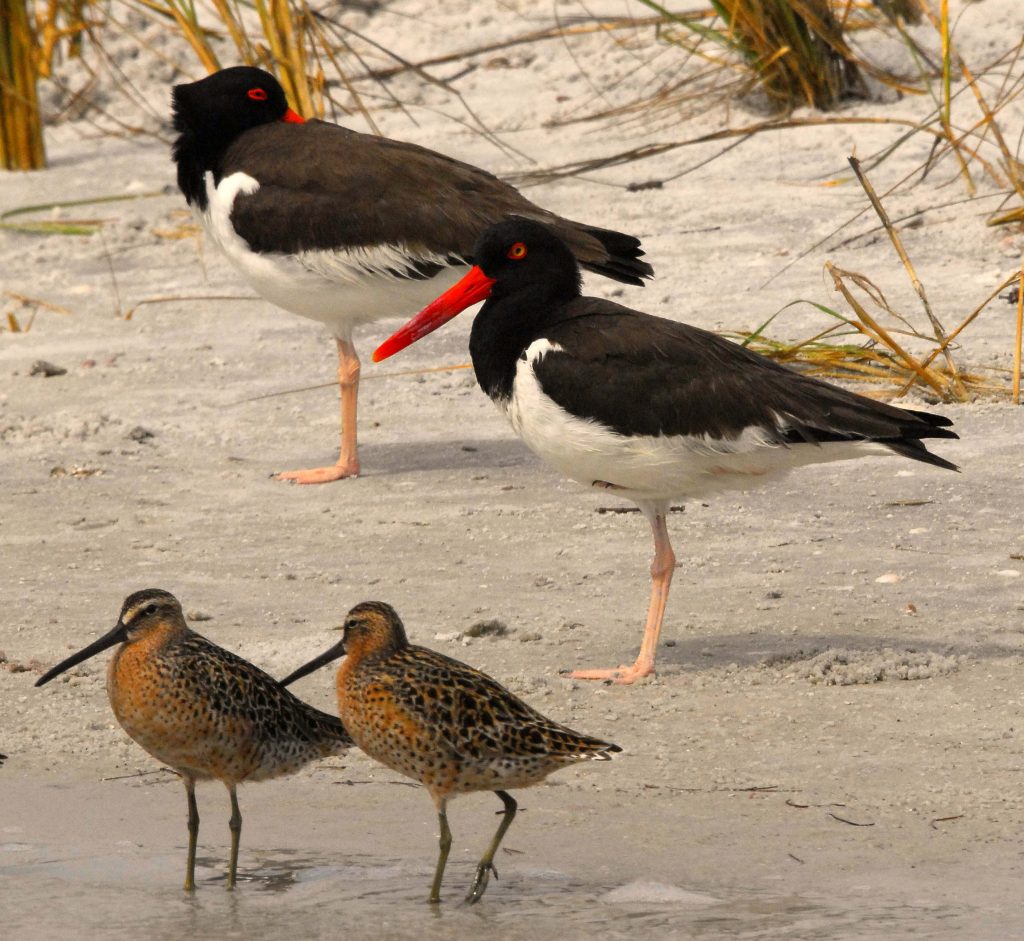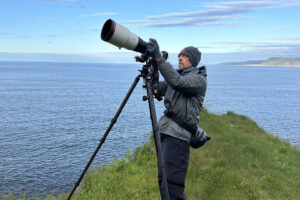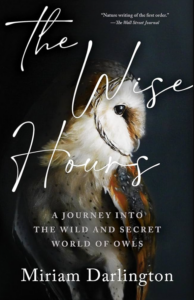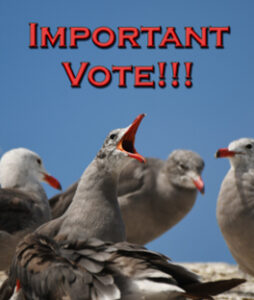
By Kim Adelson
Walking along the coast in Western Washington – along estuaries or on the beach – you can potentially spot about 70-80 species of birds. (This does not count birds you might see from shore, but who are really in nearby habitat such as in trees behind the beach, rarities, or birds you would likely have to see from a boat.) These birds are an important part of these salt-water-to-land transitional ecosystems in that they disperse the seeds of the plants that grow there (e.g. geese and ducks), they eat plant predators (e.g., Purple Martins), and they and their eggs provide food for resident animals (e.g., plovers, puffins).
Unfortunately, the climate crisis is taking/will take its toll on many of these birds. In particular, National Audubon has concluded that about 50 species of coastal birds are at high risk if we do little to stem climate change and experience a 3oC rise in average global temperature; an additional 20 species of these birds are at moderate risk. Shore-dwelling species highly at risk include Snow Geese, Lesser Scaup, Surf Scoter, Barrow’s Goldeneye, Black-bellied Plover, Semipalmated Plover, Ruddy Turnstones, Surfbirds, Sanderlings, Dunlins, Western Sandpiper, Short-billed Dowitchers, and Pacific Loon.
Why, exactly, does climate change affect shorebirds? Sea level rise, due both to melting glaciers and to the fact that warmer water takes up more space than colder water, is a major contributor. In this region the effects on beaches, mudflats, and estuaries will be exacerbated because our land is subsiding (sinking) due to movement of the tectonic plate we sit upon. In other words, we would see increased coastal flooding even if sea levels remained constant. Coastal flooding causes erosion, can result in land area being permanently converted to ocean, and can leave land that is periodically covered by sea water salinized and unable to support the plant life that it formerly had.
We can also expect to experience more frequent and more severe storm surges: warmer air and water temperatures fuel storm strength, and higher water baseline levels mean that more water is pushed onto land when storms do occur. Storm surges also lead to increased erosion and salinization and they can knock down trees and shrubs that grow near the shoreline.
There will likely also be loss of migration stopover points, so critical to many migrating birds, as low-lying areas flood. Some stopover points are “islands” or resources in an otherwise unfriendly environment, and their destruction will make it difficult for the migrants that use them to find feeding and resting spots.
Finally, warming will result in a reduced food supply for many bird species. This is due to at least three separate mechanisms. First, habitat loss, as described above. Second, higher carbon levels in the atmosphere result in higher concentrations of carbon in sea water – and when carbon is dissolved in water carbonic acid is produced, resulting in more acidic seawater. This can be devastating to clams, oysters, crabs, and any other organism that has a calcariferous shell and thus to any other animal that feeds upon them (and so up the food chain). Third, oily fish (smelt, sardines, etc.) provide more calories-per-bite than non-oily fish, and these fish thrive in colder waters. We are already seeing turnover of feeder fish populations from oily to non-oily, and birds who feed on these fish are taking in fewer calories in a day’s foraging.
So, what can you do to help shorebirds? First and foremost, you can be sure that you vote, every single time you get the chance, for politicians who are concerned about the climate crisis and who will support policies that limit carbon emissions. Write your legislators to let them know how you concerned you are about climate change. These policies include funding for public transit, institution of a carbon tax, and support for clean energy development. In your own life, you can reduce, reuse, and recycle. Reduce the amount of food you waste; bundle your trips to waste less gasoline; put on a sweater and turn your thermostat down a bit to reduce electricity usage. Consider buying fewer durable goods (such as clothing, electronics, and home furnishings) and using them longer, and stop buying single-use items. By doing this you minimize the production and transportation costs of the items you do use. Recycle whatever and whenever possible, since items that end up in landfills break down and put more greenhouse gases into the atmosphere.
Shore birds face non-climate-change related stressors as well, and you can do your part to reduce these. For example, they suffer greatly from pollution, especially plastic pollution. So, clean up other people’s trash from the beach and don’t litter yourself. The worst culprits: fishing line, balloons (and their strings), and chunks of plastic. Birds get fishing line and balloon strings wrapped around themselves and choke; they eat these items and they lacerate their digestive tracks. Balloons, especially Mylar balloons are shiny and silvery – just like the fish that make up much of many shorebirds’ diets. The birds snatch them up after they deflate and land in water or on the shore, and they get stuck in and fill their stomachs. Plastic pieces can survive digestive juices and eventually entirely fill birds’ stomachs so that they starve.
Many shore birds build their nests on bare sand or on the ground in patches of sea grass. This makes their eggs vulnerable to crushing and predation. It also means that you can readily closely approach the nests, which can scare off the parents and leave eggs to open to harm. Please remember to keep your distance and leave nesting birds alone! And, if you bring your dog to the beach, keep him/her on a leash and away from any birds you find. Even if there are no nests in sight, dogs frighten birds away and disrupt their feeding. As always, keep cats indoors. Also, “natural” predators such as raccoons, gulls, and crows are attracted by food, and so don’t leave any food on the beach. Burying the food does little good, since many predators can still sense the food even if it is covered by some sand. In general, respect restricted areas and keep away!
The bad news is that our coastal birds are threatened by climate change; the good is that we still have time to act to help most of these species. If we make changes and hold global temperature rise to 1.5oC (as we would if we adopted the goals set by the Paris Climate Accord), we cut the number of highly vulnerable coastal species by about 75%. Some of these birds remain at risk, but moderately rather than highly so, and some are no longer climate endangered at all. If you’d like more detail, please go to https://www.audubon.org/climate/survivalbydegrees/flyway/pacific.







